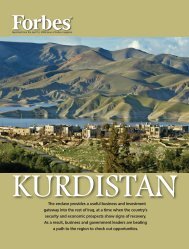Alberta
Alberta - Insight Publications
Alberta - Insight Publications
- No tags were found...
You also want an ePaper? Increase the reach of your titles
YUMPU automatically turns print PDFs into web optimized ePapers that Google loves.
Reprinted from the June 4, 2007 issue of Forbesspecial advertising section<strong>Alberta</strong>Canada’s new KlondikeINVESTING IN THE FUTURECanada is wealthy, politically stableand socially tolerant or “cool,” asmany people like to define it.Deep in its rock formations lies thebiggest oil sand deposit in the world,and that deposit’s energy content is sogreat that many geologists claim thatthere may be more oil in <strong>Alberta</strong> thanSaudi Arabia — 180 billion barrels ofproven reserves, according to the lateststatistics.The sands have been mined since the1970s, but it is only in the last fewyears, thanks to rising oil prices, thatthese deposits have become so valuable,and comparisons with the Klondike goldrush of the late 1890s now abound.Squeezing oil from rocks is certainlymuch more expensive than drilling ahole in a conventional oilfield, so theprice of crude needs to be above $50 abarrel to make the venture profitable. Itmay be a volatile investment, but<strong>Alberta</strong>’s 3.2 million inhabitants areenjoying the ride for the time being.<strong>Alberta</strong>’s economy is growing fasterthan that of any of the other nineCanadian provinces, and the only regionof the country not exceeding its annualbudget. “If you were to pull <strong>Alberta</strong> outin terms of economic growth, the rest ofCanada would suddenly be flat,” states<strong>Alberta</strong> Premier Ed Stelmach.To claim that <strong>Alberta</strong>’s success is onlythe fruit of geological roulette wouldnot do justice to the history of thisprovince and the exceptional entrepreneurialspirit of its people. “<strong>Alberta</strong>nshave a can-do attitude that does getthings done,” says Iris Evans, the ministerof Employment, Immigration andIndustry. “The legacy of the entrepreneurswho have been pioneers in thisprovince is still palpable in our society.”Poles, Ukrainians, Russians, Swedesand Americans settled there when<strong>Alberta</strong> became a full province in 1905,and, when it comes to immigration,Canada is still one of the most tolerantcountries in the world. <strong>Alberta</strong>ns are particularlyproud of their cultural diversity.“What I see in our society are fewerclass distinctions and more acceptanceof people,” says Evans, who stronglysupports more immigration, aware thatemployee shortages are the province’snumber one economic hurdle.Canada has traditionally been one ofthe United States’ closest allies, and<strong>Alberta</strong>’s oil sands have strengthened thisalready solid relationship, providing aboost for North America’s energy security.“U.S. investment in <strong>Alberta</strong> got our oiland gas industry off the ground,” saysStelmach, but the bilateral ties betweenthese two neighbors goes way beyondoil. Canada and the U.S. share theworld’s longest undefended border andthe largest bilateral trade — worth $700billion a year — and <strong>Alberta</strong> may well beone of the strongest links. ❖Marco VendittiCOVER IMAGE: © SHAUN CUNNINGHAM
2 <strong>Alberta</strong> special advertising section“Treasure in the sandsWhen I travel outside <strong>Alberta</strong>,especially abroad, I see thatpeople have no idea howmuch oil there is up here,” says GordonPanas, president and chief executive ofLockerbie and Hole, one of the country’slargest construction firms, with morethan a century of experience in <strong>Alberta</strong>.Company executives like Panas knowthe province’s natural resources like theback of their hand, but as large discoveriesbecome increasingly rare worldwide,<strong>Alberta</strong>’s oil sands are attracting theattention of the international oil industry.Shell Canada already runs the largesttar-sand project in the province and ishoping to increase its production to500,000 barrels a day from the current150,000. “A production of global significance,”says Clive Mather, the company’spresident and chief executive.Although Canada produces 2.6 millionbarrels a day, the country hasn’t yetattained the status of an oil superpower,mainly because <strong>Alberta</strong>’s tar sands arestill too expensive, technically challengingand environmentally tricky to exploit.With so much at stake, innovation andresearch and development are the namesof the game. Both local companies andoil multinationals have been investing afortune in reducing the cost of extractingoil from ever deeper deposits, and itappears to have paid off. Today, it costsaround $10 to produce a barrel of oilfrom tar sands, down 300% from thecost three decades ago.“Conventional oil and gas productionpeaked in 2004, anddespite drilling more and morewells, we’re getting less and lessproduction,” says Brent Nimeck, thechief operating officer and cofounderof Lexington EnergyServices, one of Canada’s fastestgrowingoilfield services companies.“Now we’re focusing mainly on theoil sands, which offer tremendousgrowth opportunities.”Lexington Energy has developed amobile nitrogen generation unit, which isable to extract the gas directly from airand supply it on location, dramaticallycutting the costs of transporting it in liquidform. “We designed a system that isunique in North America and probably inthe whole world,” says Nimeck, whosecompany is publicly traded on the Overthe Counter Bulletin Board (OTCBB).“Our emphasis has always been ontackling difficult projects,” says Panas ofLockerbie and Hole. “There are some ofthe world’s largest cranes operating overhere, and some of the equipment is justmind-boggling.”<strong>Alberta</strong>’s oil sands are not a businessfor the fainthearted, but the rewardsseem to justify the effort. Gibson Energy,a subsidiary of Hunting PLC, was alreadyin <strong>Alberta</strong> in 1953 selling crude oil onbehalf of Anglo American Oils, andtoday it is the country’s premier midstreamcompany. “Oil price is quitevolatile at the moment, and I think it willRefinery workercontinue to be so over the next 18months,” says Terry Gomke, the company’spresident and chief executive.Because Gibson Energy owns the oilwhile moving it across North America,linking upstream producers with downstreamrefiners, the company is particularlyexposed to price risks. But Gomkehas no doubt that Gibson’s future willremain in <strong>Alberta</strong>.“I think that in five years the companywill be much larger, even morediverse and will continue to be a majorplayer in the Athabasca region, evenwhen the oil is gone,” he says, confidentthat in the meantime the industrycan provide a long period of sustainablegrowth and plenty of opportunities fordiversification. ❖ Marco VendittiProject Managers: Mieke Hesemans, Gabriel Gutierrez ySanchez, Jeff Hanke. Publisher: John Gasser. Managing Editor:Beverley Blythe. Art Director: Y. Taravilla-Marin.This special advertising feature was produced by InsightPublications, a division of Impact Media Global Ltd.53 Chandos Place, London WC2N 4HS, UK.Tel: +44 20 7812 6400 Fax: +44 20 7812 6413150 East 55th Street, 7th Floor, NY, NY 10022, USA.Tel: +1 212 751 1900 Fax: +1 212 751 0088www.insight-publications.come-mail: publisher@insight-publications.com© CARSON GANCI
special advertising section3Capital of cultureand business acumenThe impact of <strong>Alberta</strong>’s oil and gasindustry is rapidly changing thelandscape of Edmonton, its capital.Its business district is bustling with constructioncranes, and new town houseskeep popping up along the NorthSaskatchewan River. At least $87 billionin capital investments are on their way to<strong>Alberta</strong> in the next decade, andEdmonton is gearing up to absorb thebiggest chunk.While Edmonton’s economic growth isthe highest in Canadian history, manypeople are asking if the current boom issustainable. Within a generation theprovince’s conventional oil reserves willprobably run out and, while the oil sandsdeposits will last much longer, only continuedhigh prices will make these worthexploiting. So is there a plan B?“Clearly we have to work at diversifyingthe city’s economy, notwithstandingthe fact that energy is going to be amain factor for a long period of time,”says Allan E. Scott, president and chiefexecutive of the Edmonton EconomicDevelopment Corporation (EEDC), anonprofit organization wholly owned bythe city of Edmonton.The main objectives of the EEDC are topromote next-growth industries such asBattling to be competitiveRepercussions from a governmentdecision in 2006 to tax income trustsare aggravating the sector, which hadmushroomed to a market value of morethan $183 billion.Many of the trusts are resource-based,particularly those in oil and gas, such asProvident Energy Trust, which has itsheadquarters in Calgary. Provident wasformed by a conversion in 2001 fromFounders Energy Ltd. and has grown to$872 million in value.Last year’s announcement by federalFinance Minister Jim Flaherty haschanged the landscape for all trusts byincreasing the cost of capital, leavingthem at a disadvantage relative to themaster limited partnership (MLP), a trustlikestructure in the U.S.“What the government fails to realizeis that if we fail to dilute this U.S. cost ofcapital advantage, particularly in strategicassets like some of our midstreamassets, they are going to fall into foreigntourism, or knowledge-based sectors likehealth care and education, taking advantageof the fact that the city has an idealcorporate tax structure and is among thelowest-cost centers in the country fordoing business. “Although the economyhas heated up lately, setting up an officehere is still much cheaper than in anyother major city in Canada,” says Scott.Business clusters in the GreaterEdmonton area have also been successfullyimplemented, especially in the fieldsof food processing, life sciences, forestryand nanotechnology, all of which requirespecialized manufacturing.Last, but certainly not least,Edmonton’s cultural industry deserves tobe showcased. The city currently holdsmore than 30 festivals annually, focusingon music, theater, dance, food and popularculture. As recognition, Edmontonhas been selected as the 2007 CulturalCapital of Canada.“I always felt that one way to attractpeople to Edmonton was through artsand culture,” says Stephen Mandel,mayor of Edmonton. “ManyEdmontonians are concerned that we arenot as well known as other Canadiancities such as Calgary, but we have to goabout building our business and ourstrength as we move forward, as well aspromoting ourselves in an effectiveway.” ❖ Marco Vendittihands,” says Provident President andChief Executive Thomas Buchanan. “Thetax of the energy trusts in particulardoes not make a lot of sense.”Under an income trust structure, trustspay little tax, with the bulk of earningsdistributed to trust unit owners, who thenpay tax on the distributions as income.Flaherty argued that the structure wascosting the Canadian treasury $436 milliona year in lost taxes. Opponents ofthe move — including the Calgary-basedCanadian Coalition of Energy Trusts,which sprung up to oppose the policy —have lobbied hard to change the government’smind, but to no avail.Buchanan says that Provident, whichowns an MLP in the U.S., has more flexibilitythan most trusts and is consideringits options.“Having three business units puts us inan enviable position because we have alot more flexibility than a pure upstreamor pure midstream trust might have,”says Buchanan. ❖ Geoffrey Scotton, seniorbusiness writer with the Calgary Herald
4 <strong>Alberta</strong> special advertising sectionPrivate and public commitmentCGI, one of Canada’s largest IT andbusiness service firms, values proximityto its customers as one of themost important aspects of the business.“Our strategy is local first and globalthereafter,” says Michael Roach, thecompany’s president and chief executive,who believes that IT sector clients wantto buy services mainly from companiesthat operate in their own community. Tooffer this, CGI is present in 16 countrieswith a network of more than 100 officesaround the world.Founded by Serge Godin in Québec in1976, CGI today employs more than25,000 professionals, providing end-toendservices and a wide range of IT solutionsfor a diverse client list such as BellCanada, Bombardier Aerospace andCirque du Soleil ® .“My desire when I started the companywas to serve, watch our clients succeedand get a pat on the back for beinga part of it,” says Godin. But CGI hasachieved much more than that over thepast three decades. The company’s revenuesamounted to $3 billion in 2006. Inthe same year CGI signed global dealsworth close to $4 billion, whichincreased the company’s contract backlogto more than $10 billion.In the future, CGI wants to strengthenits presence in the U.S., which alreadyaccounts for more than a third of thecompany’s income. Canada is currentlyCGI’s biggest market, and the westernprovinces in particular, including <strong>Alberta</strong>,have provided some interesting contractsand acquisitions in recent years.“Our commitment in <strong>Alberta</strong> is dividedbetween two business units, dealingmainly with the public sector inEdmonton and the oil and gas industryin Calgary,” says Bob Morrin, the Irishbornregional vice president of the officein Calgary.CGI entered <strong>Alberta</strong>’s market in the1990s through the acquisition of SystemsWest Consultants and has supportedthe transformation of the province’sbusiness environment ever since.Two emblematic contracts in this keymarket demonstrate CGI’s private andpublic sector client focus in the province.The first, in the private sector, is a productionaccounting solution for theupstream oil and gas industry. CGI’sunique partnership approach facilitatedthe creation of a consortium of usuallycompetitive oil and gas production companies.Together, they are developing aninnovative solution that will meet theneeds of the original members as well asthose of the industry in the long term.The other, in the public sector, is theCalgary Health Region’s health informationexchange. This electronic healthrecord (EHR) platform is one step in aprocess that will ultimately give theprovince’s citizens and health careproviders online access to consistent andcurrent health information. The goal isincreased quality and productivity in theentire health system.“It is one of the most progressive EHRsin the country as it provides a commoninfrastructure for sharing data and information,”says Morrin. ❖ Marco Venditti











